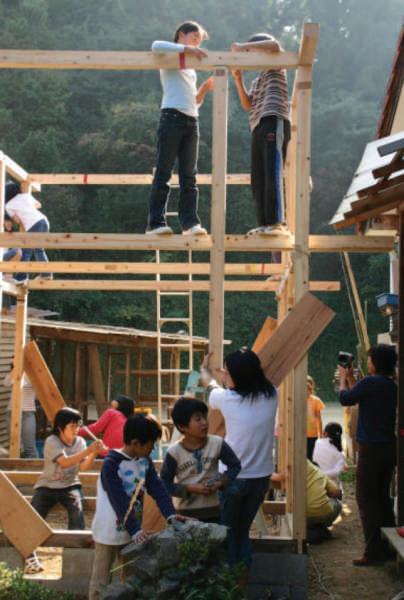
6 minute read
MIND THE GAP
Charlie Edmonds reports on how, inspired by the Kinokuni Children’s Village, vacant lots in Tokyo could be used for new urban learning modalities.
INTO THE VOID: enabling progressive education through Tokyo urbanism



The term “progressive” when used in the context of education is often troublesome and ambiguous. However, in Japan it has become interwoven with the “free school” and “new education” movements and is therefore the most commonly adopted term by Japanese education academics. Yoko Yamasaki, a leading education scholar at Kyoto University, defines progressivism as “advocating for the agency and liberation of children from the traditionally authoritarian system of schooling”. In her book, Educational Progressivism: Cultural Encounters and Reform in Japan, Professor Yamasaki explores various incarnations of progressive education in Japan since its inception in the early twentieth century. Throughout the book, recurring themes defined by progressivism include pedagogies that are democratic rather than authoritarian, which encourage greater self-direction of students in the learning process, and employ flexible demonstrations of knowledge beyond traditional standardised testing. In 2019, funded by the University of Cambridge, I was lucky enough to conduct my own research into progressive Japanese education and the role that architecture and planning might play in assisting these new learning modalities. Throughout my work, one particular form of Japanese progressive education struck me as uniquely successful: the Children’s Village schools founded by Professor Shinichiro Hori.
Kinokuni Children’s Village Professor Hori is a well-respected figure within the field of Japanese progressive education. As a student, Hori was particularly interested in the alternative education movements of the UK. He describes his academic inspiration as his “DNA”: referring to renowned twentieth-century educators, John Dewey, A.S. Neill and John Aitkenhead. As a professor, Hori was able to engage with his idols in a prolific collaboration of intercontinental ideas; he frequently visited Neill’s Summerhill School in England as well as Aitkenhead’s Kilquhanity School in Scotland. Eventually, Hori proposed to the Japanese Ministry of Education that a new school be established, founding Kinokuni Children’s Village in 1992. The school was intended as a reaction to what Hori saw as the three core failings of public education in Japan: a lack of self-esteem, the cramming system and outdated values taught through government-approved textbooks. In the summer of 2019, I had the good fortune to visit Kinokuni Children’s Village myself. I was immediately struck by the ambition of the curriculum: the school implemented project-based learning on a larger scale than I had previously believed possible. Students are grouped by interest rather than age, and the education is achieved through the practical pursuit of these interests, from gardening to building. What was particularly unique about the Children’s Village from an architectural point of view, was that new facilities were often designed and constructed by the children themselves as part of their projects. I took away from this experience a greater respect for the competencies of children to build and shape their own environments.



It was evident that this educational practice was not only engaging for students, but also encouraged a sense of belonging – since the children could very literally call parts of the school “their own”. I was curious about the apparent rural focus of the Children’s Village and asked Professor Hori if he had ever considered opening a school in Tokyo; he laughed at the idea and replied, “our curriculum cannot exist in the city, we depend on spatial freedom”.
Tokyo’s children and urban play After meeting Professor Hori, I had decided that the ambition of my research would be to investigate how the Children’s Village might become the “Children’s City”. I believed that through an unconventional approach to school architecture and planning, Professor Hori’s goal of “spatial freedom” might be realised in Tokyo. The context for this new spatial strategy eventually presented itself during an interview I conducted with a Japanese architect – when he described to me the unique phenomenon of Tokyo’s “void space”. Voids are quite simply “gaps” in the urban fabric of a city, spots sometimes referred to as “abandoned” or “derelict” depending on the cultural context. Within Tokyo, void space is a common occurrence due to the city’s rapid cycle of demolition and reconstruction and its fragmented planning system. I discovered that void spaces in Tokyo already have a surprising connection to the lives of children in the city. In the late twentieth century, it was common for the city’s children to play together in vacant lots known as


TIDY. IN 3D.
If you’re designing a learning space and want to integrate Gratnells storage, you can now nd key products as models in the SketchUp 3D Warehouse.

Visit 3dwarehouse.sketchup.com and search for Gratnells.
T: +44 (0)1279 401550 E: mail@gratnells.com gratnells.com

Kinokuni Children’S Village
harappa. Through a series of interviews with adults that had played in such spaces, I learned that their primary appeal was the lack of an explicit function – children could make of them what they wished. One particular interviewee, when contemplating the protectiveness of modern parents, made a comment I found to be particularly resonant: “I don’t think children of today have that level of freedom anymore... Maybe in the digital world.”
The language of “Void Pedagogy” The result of six months’ fieldwork studying Japan’s progressive education and unique urbanism was a design thesis titled Void Pedagogy; a proposal for a new school typology which might facilitate the spatial freedom of the Children’s Village in the city. “Void Pedagogy” proposes that void space in Tokyo be formally adapted for educational means. A new kind of urban progressive school may manifest in a dispersed form across the vacant lots of Tokyo’s residential neighbourhoods. The proposal identifies a number of opportunities for such a decentralised school to offer progressive education models that have been historically excluded from the city. Project-based learning becomes achievable through void spaces, which act as catalysts for studentled building projects. A decentralised model of school also allows for greater community engagement and participation, integrating local knowledge and skills into the teaching process. The diversity of scale and permanence across different void spaces requires a formal language with the ability to respond and adapt to each individual void site, allowing the school to become both light and heavy, temporary and permanent. The proposal responds to the unique planning conditions of Tokyo, the cyclical nature of void space emerging and disappearing according to the city’s development, and the inherent potential contained within these perforations in the urban fabric. Through urban dispersal and demountable construction, “Void Pedagogy” may manifest as an architectural language that shares its values with the progressive education it enables – inviting the Children’s Village into the city.

New facilities were often designed and constructed by the children themselves… the children could very literally call parts of the school “their own”.










